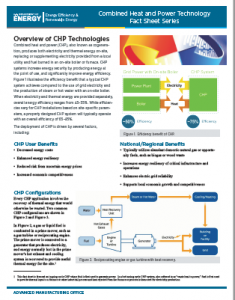The National Association of Regulatory Utility Commissioners (NARUC) dispatched good news for expanded use of combined heat and power (CHP) and waste heat to power (WHP) this week, adopting a resolution to examine issues related to standby rates. ACC is proud to support the resolution, which focuses on two important industrial energy efficiency systems.
CHP and standby rates
Also known as cogeneration, CHP is the simultaneous production of electricity and heat from the same source. Since the energy is generated close to where it is needed, little is lost in transmission. The chemical industry is a longtime leader in this innovative, energy-saving technology. CHP is a smart strategy to help reduce greenhouse gas emissions while boosting the competitiveness of many U.S. manufacturers.
While CHP systems are often able to operate independently of the central grid, they sometimes need to interconnect for supplemental or backup power, such as during an outage. Utilities use standby rates to recover the costs associated with providing these users with reliable access to grid power. But when these rates are too costly, uncertain, inflexible, or confusing, it can discourage investment in and deployment of new CHP projects.
“ACC believes the nation should strive to double electricity output generated from CHP and WHP systems. Policymakers must remove artificial barriers to distributed electricity generation, including CHP.”
– Owen Kean, American Chemistry Council
Trombold-Place resolution builds on existing efforts
Introduced by the Public Utilities Commissioners of Ohio and Pennsylvania – states with significant manufacturing activity – the resolution approved by NARUC calls for further exploration of standby rates issues; “simple, transparent, and consistent” rates; and a recognition that CHP and WHP systems offer benefits such as reduced electricity demand, lower costs, and improved system reliability and resiliency.
A diverse set of manufacturers, clean energy businesses, and efficiency and environmental advocates support the resolution. They include the Electricity Consumers Resource Council (ELCON), American Chemistry Council, American Forest & Paper Association, American Council for an Energy-Efficient Economy (ACEEE), Ohio Environmental Council, Midwest Cogeneration Association, Heat is Power, AMS Energy, Arctic Energy, Blue Sky Power, Capstone Turbines, HCS Group, and Integrated CHP Systems Corporation.
The Alliance for Industrial Efficiency has long advocated for fair, equitable, and transparent standby rates and played a leading role in engaging stakeholders in support of the resolution.
Key Facts
- CHP systems today represent over 81 gigawatts (GW) – or almost 8 percent – of the nation’s total electricity capacity. (Source: U.S. Department of Energy)
- CHP is deployed at various locations — from chemical plants to medical centers to universities — and to further promote CHP’s success, it is important to enact policies which will lift the barriers affecting its deployment. (Source: Alliance for Industrial Efficiency)
- CHP is installed at more than 4,400 commercial, industrial, and institutional facilities across the nation, improving energy efficiency, ensuring environmental quality, promoting economic growth, and fostering a more robust and resilient energy infrastructure. (Source: U.S. Department of Energy)
- CHP could supply 20 percent of U.S. electric capacity by 2030, reducing business costs and creating good-paying jobs, according to a 2008 scenario by DOE’s Oak Ridge National Laboratory. More recent technical analysis is consistent with this scenario. (Source: Alliance for Industrial Efficiency)
- If CHP provided 20 percent of U.S. electric capacity, the United States could save more than 5 quadrillion Btu (Quads) of fuel annually, the equivalent of nearly half the total energy currently consumed by U.S. households. (Source: Alliance for Industrial Efficiency)
- The U.S. Department of Energy has identified nearly 241 GW of remaining CHP technical potential capacity at more than 291,000 sites nationwide, equivalent to 480 conventional power plants. (Source: Alliance for Industrial Efficiency)
